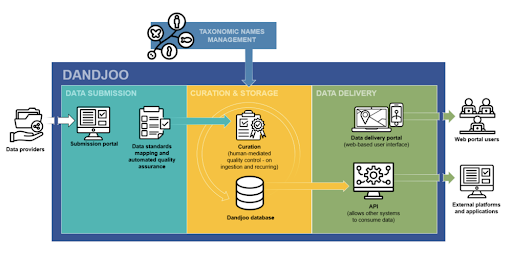We have been quietly involved in the Biodiversity Information Office (BIO) for some time (since 2020 https://www.gaiaresources.com.au/biodiversity-initiatives-australia/ right through to the major release in July 2022 https://www.gaiaresources.com.au/2022-review/ ).
We have been just re-engaged by BIO for a follow on from the pilot project to further develop the BIO systems, and this is where the thinking around our previous blog posts on the responsible use of data standards https://www.gaiaresources.com.au/responsible-use-data-standards-biodiversity-data/ has really come from.

Dandjoo is made up of multiple systems – Data Submission, Curation and Storage, and Delivery, as well as Nomos, the Taxonomic Names Management system we’ve developed for BIO
The next few months will see us collaboratively improve the functionality right across all the systems that makes up the Dandjoo platform, based on the results of the pilot project and the future directions that the BIO team are driving towards. It’s been great to work with the BIO team to ensure that we have a good way forward, both for BIO and for the broader community, and it’s going to be a great thing to work further on Dandjoo.
BIO and the Dandjoo platform is a key part of how biodiversity data is managed within Western Australia, but it is only part of a much wider ecosystem of data moving around other processes, organisations and people.
One of the internal projects that we’ve been working on here is to develop a more holistic view of the entire biodiversity ecosystem and data management landscape across the country, to work out how this flows – trying to create a way of representing this is a real challenge in itself – so we’re looking at some interesting ideas around capturing provenance and those sorts of things using the technologies that we’re implementing, like graph databases, to see where that can help us with this. Technology in the biodiversity data management space has a lot of great opportunities at the moment – right through to the use of Artificial Intelligence and Machine Learning – that are really starting to show promise across a lot of what we do here at Gaia Resources.
Our work with BIO has already commenced and will continue for the next few months – so look out for some more updates from us around this project in due course.
For more information on our work with BIO, or how we can help you manage your biodiversity data, drop me a line here, or start a conversation with us on our social media platforms Twitter, LinkedIn or Facebook
Piers

Comments are closed.